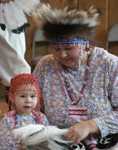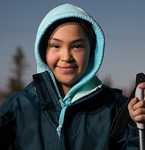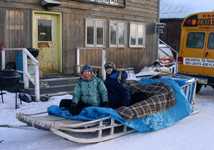Improving Health for Alaska and Arctic Residents

Arctic Investigations Program
For more than 40 years, CDC’s Arctic Investigations Program (AIP) has collaborated with the Alaska Native Tribal Health Consortium, the State of Alaska, and other partners to tackle infectious disease threats using state-of-the-art laboratory diagnostics, epidemiology, outbreak investigations, and targeted research. By focusing on reducing and preventing infectious diseases that disproportionately affect American Indian and Alaska Native people, AIP helps everyone living in Alaska enjoy healthier and longer lives.

Running water in homes

Approximately 20% of rural Alaska homes lack running water and sanitation services, making handwashing, bathing, and cooking practices a challenge. AIP studies showed that running water and sanitation in homes prevent the spread of infectious diseases like bloodstream infections, pneumonia, and skin infections. This work resulted in policy changes at the US Department of Agriculture that have made it easier to get water and sewer grants, which can help to provide more homes with running water.
Preventing severe infections in children

Historically, Alaska Native children have suffered from severe bacterial infections— meningitis, pneumonia, and bloodstream—caused by Haemophilus influenzae type B (HIB) and pneumococcus. Laboratory-based surveillance by AIP showed rates of these infections among Alaska Native children to be close to the highest worldwide —up to 10-times higher than non-Alaska Native children.
After the introduction of effective childhood vaccines, AIP researchers documented a more than a 95% decline in these vaccine-preventable cases. However, AIP surveillance also detected the emergence of new types of bacteria not covered by the vaccine. In 2009, AIP researchers introduced a more effective vaccine in rural Alaska. Today with routine use of these vaccines, infection rates are lower than they have ever been and the disparity in illness between Alaska Natives and other state residents has been substantially reduced.

Did you know?
In 1925 a diphtheria outbreak in a village over 600 miles northwest of Anchorage threatened to become a full-blown epidemic. Dog mushers from around Alaska joined forces to carry life-saving diphtheria serum to Nome. The Great Race of Mercy is commemorated each year by the Iditarod dog sled race.
Specimen Bank

The AIP laboratory maintains the Alaska Area Specimen Bank, a repository of more than 400,000 human samples and infectious agents from research in Alaska dating back to the 1960s. This collection has proven to be a critical asset for improving the health of Alaskans.
For example, stored samples from patients diagnosed with liver cancer due to hepatitis B infection validated the use of a simple blood test to routinely screen patients for early cancer detection. These efforts have markedly improved the survival of people with this form of cancer. The Specimen Bank is co-managed by CDC and Alaska Native tribal leaders to ensure the ethical conduct of research and the best use of the specimens.
One Health to address a changing climate

AIP and the Alaska Native Tribal Health Consortium have formed a One Health working group to better understand and respond to issues at the interface of human, animal, and environmental health. This group supports the Local Environmental Observer network and helps the Alaska tribal health system understand and respond to climate change. AIP scientists are working to evaluate animal-to-human infectious threats that may be sensitive to climate change, such as intestinal giardiasis, which can be transmitted from beavers and may be moving northward in Alaska.
- Page last reviewed: November 18, 2016
- Page last updated: November 18, 2016
- Content source:


 ShareCompartir
ShareCompartir